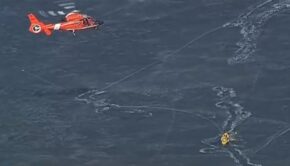Ice sailing: The frigid equalizer
Published on February 24th, 2022
Each winter hundreds of sailors take to the frozen lakes in search of the perfect run and that perfect rush. One such sailor is Quantum-powered Minnesota native Erin Bury. A year-round sailor, she embodies the challenger mentality with a zest for adventure. In this report by Quantum Sails, Erin provides a first-hand look into this awesome sailing subculture and what drives her:
Imagine: You’re in the middle of a lake. It’s January. You dropped whatever you were doing and packed everything else to drive 400 miles to get to that lake. Why the long drive? For that sheet of ice a mile away from shore − far from bathrooms and heat and where the windchill isn’t buffered by trees.
It’s 18˚F, yet there are 50 people out here with you, and everyone is smiling. That sheet of ice is the best sheet of ice on the continent, at least in that moment.
Within the discomfort that may arise in such conditions, ice sailors are out here together, and we know it. It’s part of the experience. We all share the love of speed and exhilaration and the unique challenges we’ll have to face. Ice sailing provides us with the chance to push ourselves as sailors in different ways, not to mention in a different environment.
We sail a one-design DN boat. Every builder is required to adhere to the exact specifications of the DN Class Rules and their interpretations issued by the Technical Committee. Currently, ice sailing is a niche sport, which means gear and equipment come from a variety of creative sources. On any given sheet of clean ice, you may see gear ranging from rock-climbing harnesses to yoga mats to mud flaps.
I think I speak for many ice sailors when I say our gear is the result of a lot of weird trips to hardware and outdoor supply stores.
We also sport a more recognizable kit, like a craft that has a boat-like essence to it, if you ignore the runners, and of course a sail. For sail controls, the iceboat has the familiar tiller and mainsheet, but that’s about it. It’s similar to an A-Cat. It has an outhaul that you set before the start and leave alone during the race. A fully trimmed sail hidden behind the mast is a happy sail.
If you think an A-Cat is responsive, multiply that by 10; that’s how sensitive an iceboat can be.
For example, in order to do a port tack, you must feather a bit, let the sheet out a little, push the tiller towards starboard, duck under the boom, and sheet in immediately. Because these boats harness apparent wind like no other, it’s important to “keep the boat wound up.” If a sailor can do that, their iceboat can travel three times faster than the wind speed.
Despite molecular differences between soft and hard water, ice sailing made me a better catamaran sailor. I learned how important it is to be quick on a tack or jibe, how to really harness apparent wind, and how to sail by feel.
Soft water has the advantage of showing you where puffs are on the water, but since frozen water is solid, you can’t rely on the telltale darker areas to find a desired wind line. Ice sailors watch others in the fleet, follow gut instincts, and use apparent wind to get them to the next puff wherever it may be.
My last ice sailing article revealed that we have the opportunity to tailor our boats to our bodies and abilities (class rules allow room for customization for height, weight, physical abilities, etc.). But when gender, age, body type, socioeconomic status, education, and ethnicity are not steering the competition, what is left to warrant a race? What remains is the inventiveness of sailors.
When it boils down (or freezes up) to ingenuity, athletes can truly push each other to become better and meet new challenges head on.
In the ice sailing world, there is no ice sailing store, so our outfits are customized as much as our boats, and we sometimes find it difficult to identify one another once the gloves and helmets are on. We know each other by sail number.
But underneath our various and unique layers of rock-climbing harnesses, snow pants, helmets, goggles, track cleats, and Flex Seal, there is a shared devotion. We may be cold on the outside, but we have fire in our hearts. We go through great lengths and to great heights (literally as we drive thousands of miles to sail in the mountains of Montana for The Hard Water Summit.) to sail on ice, even for just one rip a year.
If ice sailing is anything, it is a confidence booster and community builder. These days we are hearing “female empowerment” quite a bit. What about just “empowerment?” If you’re looking to harness your strengths and enjoy yourself so much that you forget about any weaknesses you thought you had, come join us on the ice.
For the first time as a woman in athletics, I feel honored and respected in a realm of true equity. I stand at five feet and 109 pounds soaking wet − maybe 111 pounds if I’m dry and wearing all my ice sailing gear.
I had my first swim meet at ten years old, and I have been an athlete for as long as I can remember. I still swim competitively and have spent years fielding comments like, “Aren’t swimmers supposed to be tall?” My response usually includes: “For every one stroke my tall competition takes, I take two, and I don’t notice if I’m in the lead.”
In ice sailing, it is refreshing how my small stature is appreciated as a superpower, and my gender does not determine who I share a racecourse with. On the ice, I am warmed with comments like, “Oh crap, she’s going to take off like a rocket.”
I am tiny and can point like no one else. I am Erin Bury, DN5397. I am ambitious. I am happy. I am strong. I am intelligent. I am evolving. I am part of a fleet that is driven by ingenuity that is powered by passion. We are a connected community that collectively agrees to get cold and go really fast.
I invite you to ignore the urge to be humble and share how cool you are. Honor your superpower and bring it to the ice where everyone is nice!
To learn more about ice sailing: jim.gluek@melges.com









 We’ll keep your information safe.
We’ll keep your information safe.